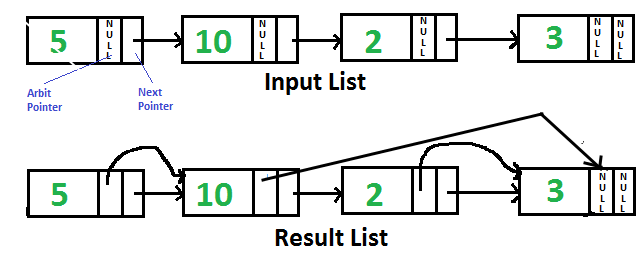

Java Program For Pointing Arbit Pointer To Greatest Value Right Side Node In A L...
source link: https://www.geeksforgeeks.org/java-program-for-pointing-arbit-pointer-to-greatest-value-right-side-node-in-a-linked-list/
Go to the source link to view the article. You can view the picture content, updated content and better typesetting reading experience. If the link is broken, please click the button below to view the snapshot at that time.

Java Program For Pointing Arbit Pointer To Greatest Value Right Side Node In A Linked List
- Last Updated : 30 Dec, 2021
Given singly linked list with every node having an additional “arbitrary” pointer that currently points to NULL. We need to make the “arbitrary” pointer to the greatest value node in a linked list on its right side.

A Simple Solution is to traverse all nodes one by one. For every node, find the node which has the greatest value on the right side and change the next pointer. The Time Complexity of this solution is O(n2).
An Efficient Solution can work in O(n) time. Below are the steps.
- Reverse the given linked list.
- Start traversing the linked list and store the maximum value node encountered so far. Make arbit of every node to point to max. If the data in the current node is more than the max node so far, update max.
- Reverse modified linked list and return head.
Following is the implementation of the above steps.
// Java program to point arbit pointers // to highest value on its right class GfG{ // Link list node static class Node { int data; Node next, arbit; }/* Function to reverse the linked list */static Node reverse(Node head) { Node prev = null, current = head, next = null; while (current != null) { next = current.next; current.next = prev; prev = current; current = next; } return prev; } // This function populates arbit pointer // in every node to the greatest value // to its right. static Node populateArbit(Node head) { // Reverse given linked list head = reverse(head); // Initialize pointer to maximum // value node Node max = head; // Traverse the reversed list Node temp = head.next; while (temp != null) { // Connect max through arbit // pointer temp.arbit = max; // Update max if required if (max.data < temp.data) max = temp; // Move ahead in reversed list temp = temp.next; } // Reverse modified linked list // and return head. return reverse(head); } // Utility function to print result // linked list static void printNextArbitPointers(Node node) { System.out.println("Node " +"Next Pointer " +"Arbit Pointer"); while (node != null) { System.out.print(node.data + " "); if (node.next != null) System.out.print(node.next.data + " "); elseSystem.out.print("NULL" +" "); if (node.arbit != null) System.out.print(node.arbit.data); elseSystem.out.print("NULL"); System.out.println(); node = node.next; } } /* Function to create a new node with given data */static Node newNode(int data) { Node new_node = new Node(); new_node.data = data; new_node.next = null; return new_node; } // Driver codepublic static void main(String[] args) { Node head = newNode(5); head.next = newNode(10); head.next.next = newNode(2); head.next.next.next = newNode(3); head = populateArbit(head); System.out.println("Resultant Linked List is: "); printNextArbitPointers(head); }} // This code is contributed by Prerna Saini. |
Output:
Resultant Linked List is: Node Next Pointer Arbit Pointer 5 10 10 10 2 3 2 3 3 3 NULL NULL
Recursive Solution:
We can recursively reach the last node and traverse the linked list from the end. The recursive solution doesn’t require reversing the linked list. We can also use a stack in place of recursion to temporarily hold nodes. Thanks to Santosh Kumar Mishra for providing this solution.
// Java program to point arbit pointers // to highest value on its rightclass GfG{// Link list node static class Node{int data;Node next, arbit;}static Node maxNode;// This function populates arbit pointer // in every node to the greatest value // to its right.static void populateArbit(Node head){// if head is null simply return // the listif (head == null)return;/* if head->next is null it means we reached at the last node just update the max and maxNode */if (head.next == null){maxNode = head;return;}/* Calling the populateArbit to the next node */populateArbit(head.next);/* updating the arbit node of the currentnode with the maximum value on the right side */head.arbit = maxNode;/* if current Node value id greater thenthe previous right node then update it */if (head.data > maxNode.data)maxNode = head;return;}// Utility function to print result // linked liststatic void printNextArbitPointers(Node node){System.out.println("Node " + "Next Pointer " + "Arbit Pointer");while (node != null){System.out.print(node.data + " ");if (node.next != null)System.out.print(node.next.data + " ");elseSystem.out.print("NULL" +" ");if (node.arbit != null)System.out.print(node.arbit.data);elseSystem.out.print("NULL");System.out.println();node = node.next;}}/* Function to create a new node with given data */static Node newNode(int data){Node new_node = new Node();new_node.data = data;new_node.next = null;return new_node;}// Driver codepublic static void main(String[] args){Node head = newNode(5);head.next = newNode(10);head.next.next = newNode(2);head.next.next.next = newNode(3);populateArbit(head);System.out.println("Resultant Linked List is: ");printNextArbitPointers(head);}}// This code is contributed by shubham96301 |
Output:
Resultant Linked List is: Node Next Pointer Arbit Pointer 5 10 10 10 2 3 2 3 3 3 NULL NULL
Please refer complete article on Point arbit pointer to greatest value right side node in a linked list for more details!
Recommend
About Joyk
Aggregate valuable and interesting links.
Joyk means Joy of geeK
